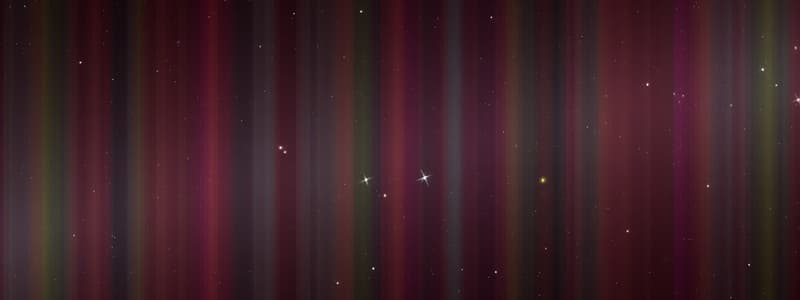Podcast
Questions and Answers
What are hydrogen Balmer lines and how do they form?
What are hydrogen Balmer lines and how do they form?
Absorption lines found in the spectra of hot stars (O, B, and A). They are caused by the excitation of hydrogen atoms from n=2 state to other energy levels (electron transition).
Why don't hydrogen Balmer lines form for very hot or cooler stars?
Why don't hydrogen Balmer lines form for very hot or cooler stars?
If a star is too hot, there are many violent collisions between atoms to excite electrons, so either hydrogen atoms are ionised or electron transition occurs at n>2, so no Balmer lines. If a star is too cool, there are few violent collisions between atoms to excite electrons, so most remain at ground state and there are few electron transitions, so no Balmer lines.
What is the equation that allows you to find the frequency of the photon emitted from electron transition to produce Balmer lines?
What is the equation that allows you to find the frequency of the photon emitted from electron transition to produce Balmer lines?
The equation is ΔE = En - E2.
What is the table of all the spectral classes of stars, including their colors, temperature ranges, and prominent absorption lines?
What is the table of all the spectral classes of stars, including their colors, temperature ranges, and prominent absorption lines?
Why do a variety of element absorption spectra need to be used to identify a star?
Why do a variety of element absorption spectra need to be used to identify a star?
What does the Hertzsprung-Russell diagram look like?
What does the Hertzsprung-Russell diagram look like?
Are the surface areas of giants and white dwarfs big or small and why?
Are the surface areas of giants and white dwarfs big or small and why?
How would you draw the evolutionary path of a star like the Sun on an H-R diagram?
How would you draw the evolutionary path of a star like the Sun on an H-R diagram?
What is the temperature, spectral class, and absolute magnitude of the Sun?
What is the temperature, spectral class, and absolute magnitude of the Sun?
Flashcards are hidden until you start studying
Study Notes
Hydrogen Balmer Lines
- Absorption lines in the spectra of hot stars classified as O, B, and A.
- Formed by the electron excitation of hydrogen atoms from the n=2 energy state to higher levels.
Formation Conditions
- Very hot stars experience excessive collisions, leading to ionization or electron transitions at levels higher than n=2, preventing Balmer line formation.
- Very cool stars have low collision rates, keeping electrons predominantly in the ground state, resulting in few transitions and no Balmer lines.
Photon Frequency Calculation
- Frequency of the emitted photon during electron transition for Balmer lines can be determined using the equation ΔE = En - E2.
Spectral Classification Table
- Spectral classes range from 0 to 10, with 0 being the hottest and 10 the coolest.
Element Absorption Spectra
- Using a variety of element absorption spectra is crucial as stars of different classes might show identical Balmer line intensity but differ significantly in temperature.
Hertzsprung-Russell Diagram
- Three main groups are depicted:
- Main sequence stars
- Giants (located across the top)
- White dwarfs (positioned in the bottom left)
- Y-axis represents absolute magnitude (increasing negatively upwards).
- X-axis shows temperature on a logarithmic scale (decreasing from left to right) or spectral class from hottest to coolest.
Surface Area Characteristics
- Giants possess large surface areas due to high pressure (P) and low temperature (T).
- White dwarfs exhibit small surface areas because of low pressure (P) and high temperature (T).
Star Evolution on H-R Diagram
- Evolutionary path for stars like the Sun can be represented on the Hertzsprung-Russell diagram.
Sun's Characteristics
- Temperature approximately 6000K.
- Classified as a G-type star.
- Absolute magnitude of +5.
Studying That Suits You
Use AI to generate personalized quizzes and flashcards to suit your learning preferences.



